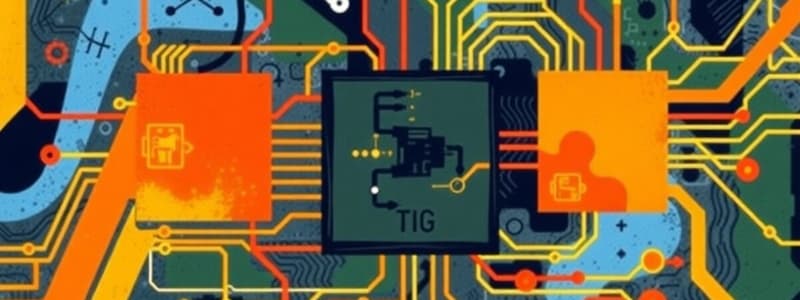Podcast
Questions and Answers
What formula represents Ohm's Law?
What formula represents Ohm's Law?
- V = I + R
- V = I × R (correct)
- V = R / I
- V = I / R
What characterizes a parallel circuit?
What characterizes a parallel circuit?
- Same voltage across each component (correct)
- Same current flows through each component
- Requires more resistance
- Connected end-to-end
Which of the following represents a characteristic of digital communication?
Which of the following represents a characteristic of digital communication?
- Analog Transmission
- Continuous signals
- Amplitude Modulation
- Discrete signals using binary (correct)
What is the primary function of modulation in communication systems?
What is the primary function of modulation in communication systems?
Which device is used to visualize electrical signals over time?
Which device is used to visualize electrical signals over time?
What defines a semiconductor?
What defines a semiconductor?
Which of the following is a feature of 5G technology?
Which of the following is a feature of 5G technology?
What is the primary purpose of a multimeter?
What is the primary purpose of a multimeter?
Flashcards are hidden until you start studying
Study Notes
Basics of Electronics and Communications
-
Electronics: Study of electrical circuits that involve the flow of electrons.
- Components include resistors, capacitors, inductors, diodes, and transistors.
- Applications range from small devices (like radios) to large systems (like satellites).
-
Communications: Transmission of information over distances.
- Forms include analog and digital communication.
Key Concepts in Electronics
-
Ohm's Law: V = I × R
- Voltage (V), Current (I), Resistance (R).
-
Circuit Types:
- Series Circuits: Components connected end-to-end; same current flows through each.
- Parallel Circuits: Components connected across common points; same voltage across each.
-
Analog vs. Digital:
- Analog: Continuous signals; examples include sound waves and radio waves.
- Digital: Discrete signals; uses binary (0s and 1s).
-
Semiconductors:
- Materials (like silicon) that have conductivity between conductors and insulators.
- Basis for modern electronics, used in diodes and transistors.
Communication Systems
-
Types of Communication:
- Wired: Includes telephone lines, coaxial cables, and fiber optics.
- Wireless: Uses electromagnetic waves; includes radio, infrared, and satellite communication.
-
Modulation:
- Process of varying one or more properties of a carrier signal with respect to the information being sent.
- Types include Amplitude Modulation (AM) and Frequency Modulation (FM).
-
Signal Processing:
- Manipulating signals to improve transmission and reception.
- Techniques include filtering, amplification, and encoding.
Important Communication Technologies
- Telecommunications: Transmission of messages over distances using electronic means.
- Satellite Communication: Uses satellites to relay and amplify radio telecommunications signals.
- Optical Communication: Transmits information as light pulses through fiber optic cables.
Measurement and Testing in Electronics
- Multimeter: Instrument for measuring voltage, current, and resistance.
- Oscilloscope: Visualizes electrical signals over time.
- Network Analyzer: Measures the response of a network to various inputs; useful in RF and microwave engineering.
Emerging Trends
- IoT (Internet of Things): Interconnected devices for data exchange.
- 5G Technology: Latest generation of mobile communications, providing higher speeds and lower latency.
- Quantum Communication: Uses principles of quantum mechanics for secure information transfer.
Safety Considerations
- Always adhere to safety protocols to prevent electric shock or equipment damage.
- Utilize protective gear and ensure proper grounding of circuits.
Electronics
- Studies electrical circuits using electron flow
- Components include resistors, capacitors, inductors, diodes and transistors
- Applications range from small devices to large systems
- Radios, satellites
Communications
- Transmission of information over distances
- Forms
- Analog: Continuous signals, sound waves and radio waves
- Digital: Discrete signals, uses binary 0s and 1s
Key Concepts in Electronics
- Ohm's Law: Defines the relationship between voltage, current and resistance: V = I x R
- Voltage (V): Measured in volts, the potential difference between two points
- Current (I): Measured in amperes, the rate of flow of electric charge
- Resistance (R): Measured in ohms, the opposition to the flow of current
- Circuit Types
- Series Circuits: Components connected end-to-end, the same current flows through each component
- Parallel Circuits: Components connected across common points, the same voltage is applied across each component
- Semiconductors: Materials that have conductivity between conductors and insulators
- Silicon is the most common semiconductor material
- Used in diodes and transistors which are the foundation for modern electronics
Communication Systems
- Types of Communication:
- Wired: Includes telephone lines, coaxial cables and fiber optics
- Wireless: Uses electromagnetic waves for transmission, including radio, infrared and satellite communication
- Modulation:
- Varying one or more properties of a carrier signal to transmit information
- Examples include Amplitude Modulation (AM) and Frequency Modulation (FM)
- AM: Varying the amplitude of a carrier signal to transmit information
- FM: Varying the frequency of a carrier signal to transmit information
- Signal Processing: Manipulating signals to improve transmission and reception
- Techniques include filtering, amplification and encoding
Important Communication Technologies
- Telecommunications: Transmission of messages over distances using electronic means
- Satellite Communication: Uses satellites to relay and amplify radio telecommunications signals
- Optical Communication: Transmits information as light pulses through fiber optic cables.
Measurement and Testing in Electronics
- Multimeter: Measures voltage, current and resistance
- Oscilloscope: Visualizes electrical signals over time
- Network Analyzer: Measures the response of a network to various inputs. Used for RF and microwave engineering
Emerging Trends
- IoT (Internet of Things): Interconnected devices that exchange data, enabling communication among objects
- 5G Technology: Latest generation of mobile communications, providing higher speeds and lower latency
- Quantum Communication: Uses principles of quantum mechanics for secure information transfer
Safety Considerations
- Always: Adhere to safety protocols to prevent electric shock or equipment damage
- Use protective gear like gloves and safety glasses
- Ensure proper grounding of circuits to prevent electrical shocks
Studying That Suits You
Use AI to generate personalized quizzes and flashcards to suit your learning preferences.




